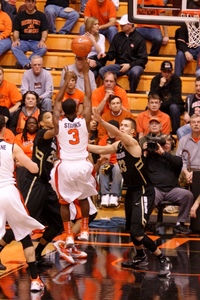Oregon State Week: Running Down The Returnees
Posted by Connor Pelton on August 23rd, 2012Six significant Beavers return for Craig Robinson this season, a group that will be called upon to quickly meld with four freshmen and a newly eligible transfer. Below we’ll break down those returnees in order of their per-game scoring averages last season.
Devon Collier, Junior, Forward (13.1 PPG, 5.9 RPG, 1.3 BPG) – Collier graduated from starting all but seven games as a freshman to all but just three as a sophomore. His scoring totals nearly doubled in 2011-12, going from 7.0 PPG to 13.1 PPG. He was by far the team’s best scoring option in the post, and at times when Jared Cunningham couldn’t find his jumper, the best option, period. The next step on the road to becoming an all-conference performer is to finish more of his opportunities off the glass. That should come as he makes the transition to an upperclassman, and he already showed some improvement in the Beavers first European Tour game, going six-for-six from the field against Saint Charles Basketball Club. If he can continue anywhere near that kind of production, he has a solid passer in Ahmad Starks to get him the ball on the block. Collier can also run the court and is a great dump-off option in transition. On the other end of the court, Collier’s defense will be just as important to Oregon State’s success this season. The combination of Eric Moreland and Collier’s long wingspans made it nearly impossible for opponents to have any success in the lane, with Devon himself having one four-block game and three three-block outings.

Once Starks Begins To Get Going, There Isn’t A Better Shooter In The League (credit: Andy Wooldridge)
Ahmad Starks, Junior, Point Guard (12.1 PPG, 2.3 RPG) – Along with Collier, Starks is the only other player from Robinson’s 2010 freshman class still with the team. Starks is a shoot-first point guard, the best of his kind in the Pac-12. Despite only standing a generous 5’9″, he is able to get up and make shots consistently with his unique fadeaway jumper. Starks was the main reason for Oregon State’s late success in 2011-12, as the Beavers went 6-2 in their final eight games. With Cunningham struggling to put down his three-point shot, Starks averaged 11.3 PPG in the seven games he played during that stretch. Not surprisingly, Oregon State’s two losses came in games where Starks scored only four points or sat out. The guard is at his best when he catches the ball on a wing or is able to create separation by stopping on a dime, pulling up, fading away, and shooting. More of this, and less of the jacking up random shots outside of the offensive flow, will result for more offensive production for both Starks and the Beavers.











































